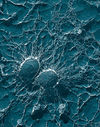Immunity to Bacteria
Overview
The immune mechanisms that defend against bacterial infection relate to the type of cell wall (see structure) and recognition of common bacterial components.
Innate mechanisms
Lipopolysaccharide recognition
LPS is a component of some Gram-negative bacterial cell walls and its recognition is thought to be an ancient mechanism that evolved before the acquired immune system. When released by bacteria, LPS can bind to soluble CD14, which causes the release of TNF-alpha and IL-1 (both lead to systemic phagocyte activation), or to lipoprotein particles, which neutralize it.
Complement
Some bacteria, particularly those with an outer lipid bilayer (i.e. Gram-negative), are susceptible to Complement activated via the alternative pathway (the lytic complex: C5b-9). The release of C3a and C5a lead to histamine release, and attracts and activates neutrophils. Components of C3 aid opsonisation of the bacteria.
Phagocytosis
Most bacteria are killed this way. Complement products, bacterial components (e.g. f-Met-Leu-Phe) and locally released cytokines are chemotactic for phagocytes. The binding of the phagocyte can be mediated by the following:**Lectins on the bacteria, e.g. mannose-binding lectin of E. coli.
- Lectins on the phagocyte, e.g. complement receptors such as CR3.
- Complement deposited on the organism, both classic and alternative pathways.
- Fc receptors on phagocyte, bind to the antibody on bacteria.
The activation of macrophages occurs after exposure to microbial products or T cell-derived lymphokines. Lymphokines released during T-cell activation are often required for full activation, such as IFN-γ.
Immunopathology
The release of endotoxins, typically LPS by Gram-negative bacteria, can cause the excessive production of cytokines that lead to 'endotoxin shock.' This can lead to fever, circulatory collapse and haemorrhagic necrosis, and eventually multiple organ failure and potentially death. Gram-positive bacteria can cause a similar reaction. The Koch phenomenon is the necrotic response observed in M. tuberculosis infections and is thought to be partly due to the release of cytokines.
==Evading immune defences==
Bacteria can avoid the complement reponse. Proteins can be expressed on the surface that divert the lytic complex from the cell membrane; The outer membrane can resist the lytic complex; Some bacteria have an outer membrane that inhibits complement activation and An enzyme found on the membrane of some bacteria is able to degrade complement.
Many can also avoid the phagocytic response by secreting repellants or toxins, some bacteria can inhibit chemotaxis. Once ingested, some bacteria inhibit lysosome fusion or proton pump action (preventing the phagocyte pH from falling), e.g. M. tuberculosis. Some bacteria have outer coats that inhibit phagocyte attachment and some secrete catalase which breaks down hydrogen peroxide. The release of a phenolic glycolipid by M. leprae prevents damage by free radicals. Lipoarabinomannan, released by some Mycobacteria, blocks macrophage response to IFN-γ and infected cells can lose their ability to present antigens.
Also see Innate Immunity to Bacteria and Adaptive Immunity to Bacteria
